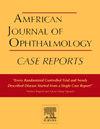De novo pediatric choroidal Osteoma: A longitudinal observation since inception and through treatment
Q3 Medicine
引用次数: 0
Abstract
Purpose
To report a pediatric case of choroidal osteoma documented from its earliest detectable stage, characterize its growth pattern, and evaluate the impact of photodynamic therapy (PDT) on tumor progression.
Observations
A 4-year-old female underwent cataract surgery in the right eye and was consequently followed regularly. At age 8.8 years old (4 years of follow-up), a subtle, amelanotic choroidal juxtapapillary lesion was detected in the left eye on fundus examination. A retrospective review of fundus photographs prior to this examination revealed no readily visible lesion at age 6.7 years. Subtle changes on fundus photography in intermediate timepoints were apparent only on close inspection. Multimodal imaging confirmed the diagnosis of choroidal osteoma. The lesion's effective basal diameter growth rate before PDT was 1.94 mm/year, faster than reported in pediatric cases. After PDT, the growth rate was 1.78 mm/year, which was not statistically different (p = 0.558). Over a five-year follow-up period, the patient maintained 20/20 visual acuity in the affected eye despite subfoveal involvement of the tumor.
Conclusions and importance
This case represents a rare instance of photographic documentation of choroidal osteoma during its earliest identifiable stages, providing unique insight into this rare tumor's natural history and progression. While PDT was performed, it neither halted the tumor's progression completely nor prevented it from extending sub-foveally. These findings underscore the importance of early detection, longitudinal imaging, and continued exploration of management strategies for pediatric choroidal osteomas.
新生儿童脉络膜骨瘤:从发病到治疗的纵向观察
目的报告一例小儿脉络膜骨瘤,从其最早可检测的阶段记录,描述其生长模式,并评估光动力治疗(PDT)对肿瘤进展的影响。观察1例4岁女童右眼白内障手术,术后定期随访。在8.8岁时(随访4年),在眼底检查中发现左眼无色素变性脉络膜旁乳头病变。回顾检查前眼底照片,发现6.7岁时没有明显的病变。眼底摄影在中间时间点的细微变化只有在近距离检查时才明显。多模态影像证实了脉络膜骨瘤的诊断。PDT前病变的有效基底直径增长速度为1.94 mm/年,比儿科病例报道的更快。PDT后的生长速率为1.78 mm/年,差异无统计学意义(p = 0.558)。在五年的随访期间,尽管肿瘤累及中央凹下,患者仍保持20/20的视力。结论和重要性:本病例是一个罕见的脉络膜骨瘤早期可识别阶段的照片记录,为这种罕见肿瘤的自然历史和进展提供了独特的见解。在进行PDT时,它既不能完全阻止肿瘤的进展,也不能阻止肿瘤向中央凹下区扩展。这些发现强调了早期检测、纵向成像和持续探索小儿脉络膜骨瘤治疗策略的重要性。
本文章由计算机程序翻译,如有差异,请以英文原文为准。
求助全文
约1分钟内获得全文
求助全文
来源期刊

American Journal of Ophthalmology Case Reports
Medicine-Ophthalmology
CiteScore
2.40
自引率
0.00%
发文量
513
审稿时长
16 weeks
期刊介绍:
The American Journal of Ophthalmology Case Reports is a peer-reviewed, scientific publication that welcomes the submission of original, previously unpublished case report manuscripts directed to ophthalmologists and visual science specialists. The cases shall be challenging and stimulating but shall also be presented in an educational format to engage the readers as if they are working alongside with the caring clinician scientists to manage the patients. Submissions shall be clear, concise, and well-documented reports. Brief reports and case series submissions on specific themes are also very welcome.
 求助内容:
求助内容: 应助结果提醒方式:
应助结果提醒方式:


